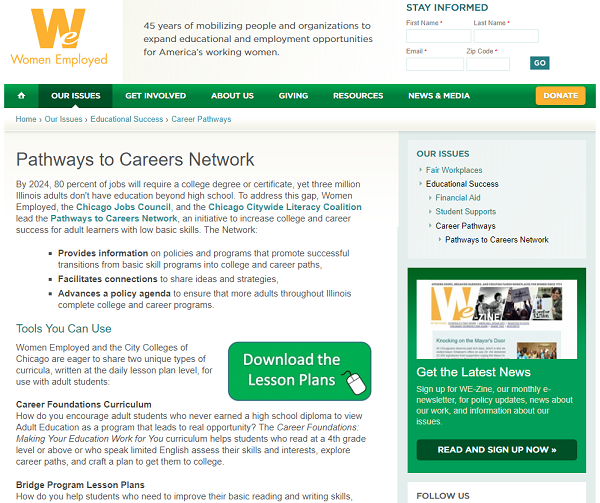- MN ABE Connect
- Archive
- Lesson Plans for Career Exploration: How to Get Started Now
Lesson Plans for Career Exploration: How to Get Started Now
Stephanie Sommers, ACES CoordinatorI knew I had found a great new resource for the Developing a Future Pathway category of the Transitions Integration Framework (TIF) when I saw this quote in the curriculum materials:
“Successful delivery results in students identifying a future focus area and developing a concrete plan with a specific timeline to complete classes, earn a GED (if needed), and transition to college.”
There was that and the fact that the curriculum was developed by Stephanie Sommers, but not this Stephanie Sommers. The curriculum in question comes from the Pathways to Careers Network, an initiative of Women Employed and the Chicago Jobs Council. The Pathways to Careers Network was started to address the gap between the growing number of jobs that require a college degree or certificate and the number of adult with no education beyond high school. The curriculum includes a large number of lessons written at the daily level for use with adults. It was co-developed by Women Employed and the City Colleges of Chicago. The lessons are divided into two main areas: career exploration and bridge programs.

Bridge Program Lesson Plans
There are currently three career clusters represented in the bridge program lesson plans: healthcare, early childhood education, and transportation, distribution and logistics (TDL). The lessons are being developed at three levels: High Intermediate (6th to 8th grade reading level), Low Adult Secondary Education (9th to 10th grade reading level), and High Adult Secondary Education (11th to 12th grade reading level).
As I write this article, only the healthcare lessons are completed for all three levels. Some of the higher-level lesson plans are missing from the other two career clusters, but according to the website, they are “coming soon.” Also coming soon are lesson plans for a new career cluster: hospitality/culinary. As more and more programs around the state start offering classes to help students earn food manager certificates, these lessons might prove very valuable.
Career Foundations: Making Your Education Work for You
There are 24 lessons included in the Career Foundations curriculum, and if used all together, they provide 48 hours worth of course material. But that is not to say that the lessons must be used in their entirety. In fact, they were designed so that programs can pick and choose which lessons they want to incorporate to create their own customized course.
The Career Foundations lessons were written for students who read at a fourth grade level or above and/or who speak limited English. For those who are familiar with the Integrating Career Awareness (ICA) Curriculum Guide from the National College Transition Network, parts of the Career Foundations curriculum will feel very familiar. Like in the ICA, there are great lessons geared towards helping students to identify their own skills, interests and values.
But there are also fun twists on these familiar lesson ideas. Lesson 8 of the Career Foundations curriculum, for example, has students using what they have learned about themselves through the self-exploration activities to create elevator speeches. Students prepare for this activity by completing a graphic organizer that has them reflect on their values; strategies they have used for past success; what type of work they are most suited to; and skills.
Another novel lesson idea is introduced in Lesson 12 and has students creating a commercial for a chosen focus area. Students conduct career exploration research on their chosen focus area (e.g. healthcare, early childhood education, customer service) and then create a commercial that explains why this particular area is their top career pick. With the recent buzz around contextualization and creating career focused basic skills curriculum, these lessons provide an easy way to begin doing career exploration activities in your classroom.
Additional Benefits
In addition to the great lessons, the curriculum materials offer clear instructions on how to customize the course and a list of suggested student course evaluation questions. There are also numerous videos and on-line resources included. In fact, some of the lessons were developed to be taught in a computer lab, and they are designated with a special computer icon in the plans. The lesson plans themselves are very detailed and ready-to-use. All of the necessary student handouts are included, and you instantly get access to all of the lessons at once simply by completing an online form on the Women Employed website. You can also link to the site from the Developing a Future Pathway section of the ACES resource library.
Newsletter Signup
Get MN ABE Connect—the official source for ABE events, activities, and resources!
Sign UpArticle Categories
- ABE Foundations/Staff Onboarding
- ACES/Transitions
- Adult Career Pathways
- Assessment
- CCR Standards
- Citizenship
- COVID-19
- Cultural Competency
- Digital Literacy/Northstar
- Disabilities
- Distance Learning/Education
- ELA
- Equity/Inclusion
- ESL
- HSE/Adult Diploma
- Listening
- Math/Numeracy
- Mental Health
- Minnesota ABE
- One-Room Schoolhouse/Multilevel
- Professional Development
- Program Management
- Reading
- Remote Instruction
- Science
- Social Studies
- Speaking/Conversation
- Support Services
- Teaching Strategies
- Technology
- Uncategorized
- Volunteers/Tutors
- Writing